Effective community building and resource management are crucial for success in Stronghold. Explore tactics to enhance player engagement through collaboration and social connections. Learn strategies for optimizing resource allocation and maintaining a balanced economy. Understand player demographics to tailor community initiatives and foster inclusivity. Discover unique gameplay features that promote interaction and strengthen community ties.
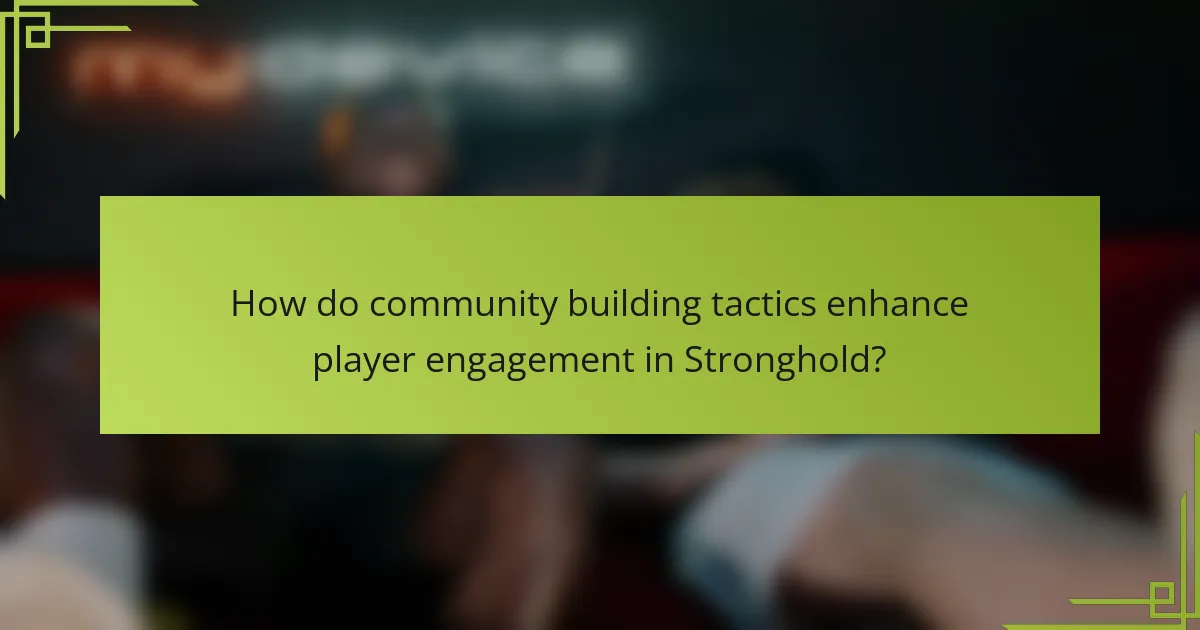
How do community building tactics enhance player engagement in Stronghold?
Community building tactics significantly enhance player engagement in Stronghold by fostering social connections and collaboration. These tactics create a sense of belonging, encouraging players to participate actively. For example, forming clans or guilds allows players to share resources and strategies, deepening their investment in the game.
Additionally, community events and competitions stimulate interaction, driving players to engage more frequently. The unique attribute of Stronghold lies in its blend of resource management and social dynamics, which sets it apart from other strategy games. As a result, players feel more connected, leading to increased retention and satisfaction.
What role does teamwork play in community development?
Teamwork is essential in community development as it fosters collaboration and shared responsibility. Effective teamwork brings diverse skills together, enhancing problem-solving and resource management. When individuals unite, they create a stronger support network, driving initiatives that benefit the entire community. This collective effort leads to increased engagement and sustainable development outcomes.
How can communication strategies foster a sense of belonging?
Effective communication strategies can significantly enhance a sense of belonging within a community. By fostering open dialogue, individuals feel valued and connected. Strategies such as active listening and inclusive messaging create an environment where everyone’s voice is heard.
Moreover, utilizing shared experiences and storytelling strengthens interpersonal bonds. These elements contribute to a unique attribute of community dynamics, promoting trust and collaboration among members. As a result, individuals are more likely to engage and invest in the community, reinforcing their sense of belonging.
Which activities promote collaboration among players?
Cooperative gameplay and resource sharing significantly enhance collaboration among players in Stronghold. Engaging in joint missions, forming alliances, and participating in community events fosters teamwork and strategic planning.
Players can also collaborate through trading resources, which helps build trust and encourages interdependence. Creating shared goals within guilds or clans promotes a sense of belonging and collective achievement.
Additionally, hosting in-game events, such as tournaments or building contests, invites players to work together, strengthening their community bonds. These activities not only improve player interaction but also enrich the overall gaming experience.
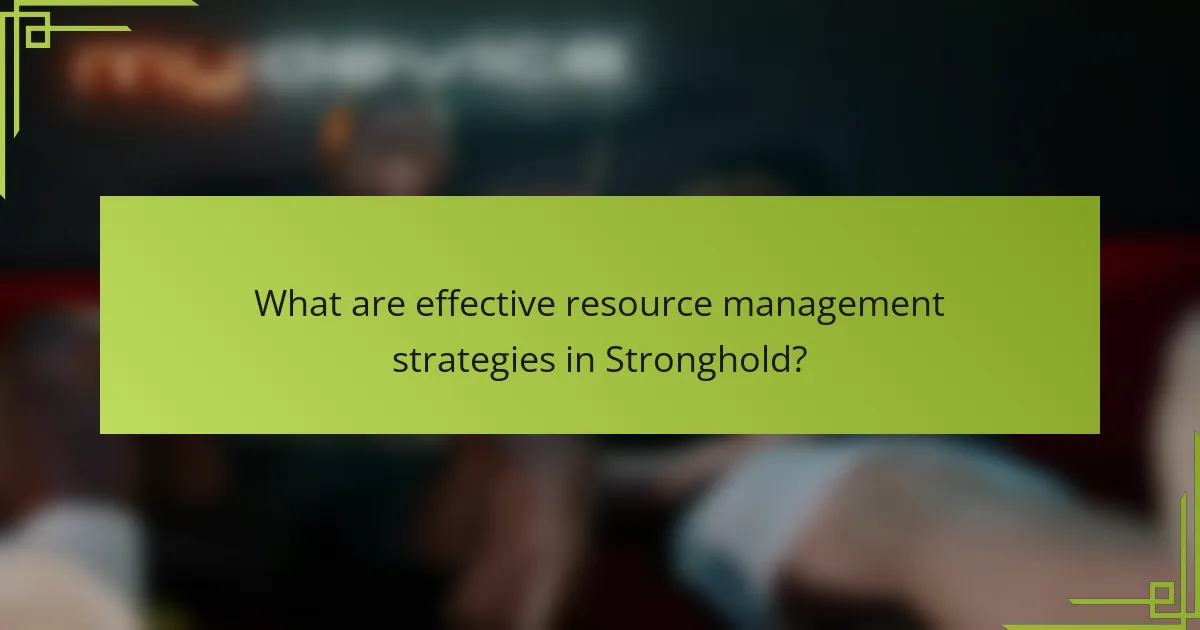
What are effective resource management strategies in Stronghold?
Effective resource management strategies in Stronghold include prioritizing resource allocation, optimizing production efficiency, and maintaining a balanced economy. Focus on gathering essential resources like food and wood early in the game. Utilize building upgrades to enhance productivity and ensure a steady supply of materials. Implement trade with neighbouring factions to acquire necessary goods while managing surplus resources effectively.
How can players optimize resource allocation for maximum efficiency?
Players can optimize resource allocation by prioritizing production efficiency and strategic upgrades. Focus on balancing resource generation and consumption to enhance community growth.
First, identify key resources such as food, wood, and stone. Invest in buildings that boost production rates. For example, upgrading farms increases food output, which supports population growth.
Next, implement a balanced approach to resource distribution. Allocate resources based on immediate needs and long-term goals. Regularly assess resource levels to avoid shortages that can hinder development.
Lastly, engage with the community to share resources and strategies. Collaborating with other players can lead to discovering unique tactics and maximizing efficiency through shared insights.
What techniques are useful for balancing short-term and long-term resource needs?
Balancing short-term and long-term resource needs requires strategic planning and prioritization. Effective techniques include resource allocation based on immediate community demands and future growth projections.
Implementing a tiered resource management system allows for flexibility. Prioritize essential resources that address urgent community needs while setting aside reserves for future initiatives.
Regularly assess community feedback to align resource distribution with evolving needs. This ensures that both immediate and long-term objectives are met, fostering sustainable community development.
Utilizing data analytics can enhance decision-making. Analyzing usage patterns helps identify trends, enabling proactive adjustments to resource strategies that balance short-term demands with long-term goals.
How can players leverage trade to enhance resource availability?
Players can leverage trade to enhance resource availability by strategically exchanging surplus goods. This approach allows players to obtain scarce resources essential for community development.
Establishing trade routes with other players can create a consistent flow of resources. Collaborating with allies ensures access to diverse materials, increasing overall efficiency in resource management.
Utilizing trade agreements can provide long-term benefits. Players can negotiate favourable terms that enhance their resource pool, enabling them to focus on building and expanding their communities.
Monitoring market trends within the game can help players identify valuable trade opportunities. By staying informed, they can maximize their resource availability and strengthen their community’s resilience.
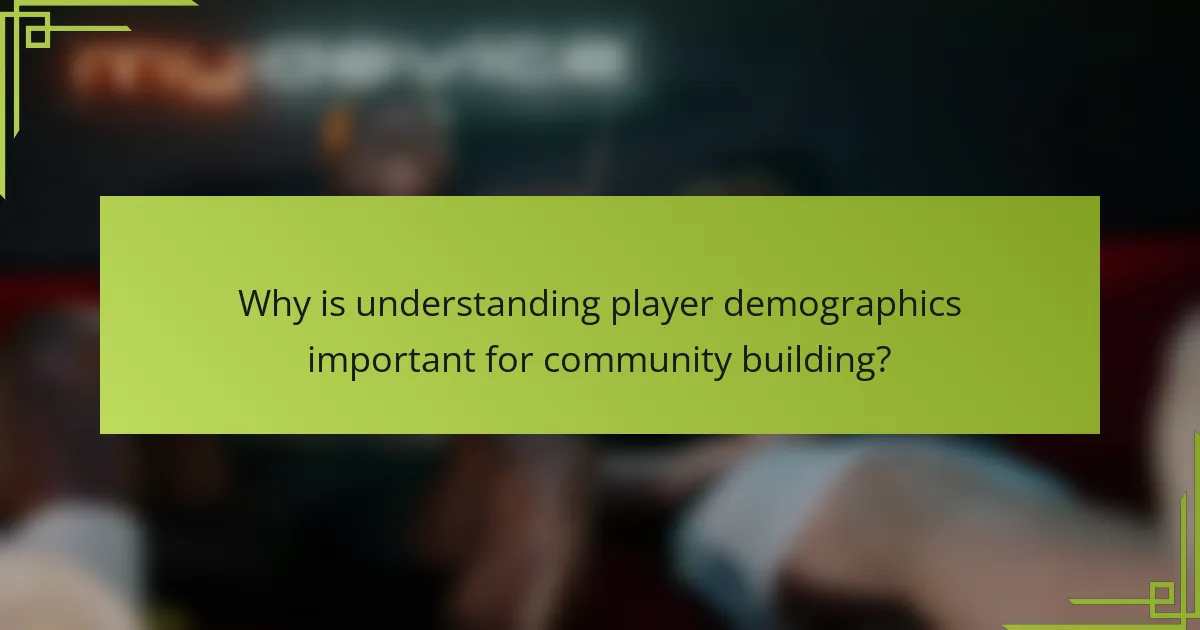
Why is understanding player demographics important for community building?
Understanding player demographics is crucial for effective community building. It helps tailor strategies that resonate with different player segments, enhancing engagement and retention.
By analyzing demographics, community leaders can identify preferences, allowing for targeted resource management. This leads to more relevant content and events, fostering a sense of belonging among players.
Moreover, understanding demographics aids in conflict resolution. Recognizing diverse player backgrounds can mitigate misunderstandings and promote inclusivity. This ultimately strengthens community bonds and encourages collaboration.
Lastly, demographic insights inform marketing strategies. They enable the promotion of community initiatives that appeal to specific groups, maximizing participation and investment in the community.
How do cultural differences influence community dynamics?
Cultural differences significantly shape community dynamics by influencing values, communication styles, and resource management approaches. Diverse cultural backgrounds foster unique perspectives, impacting collaboration and decision-making.
For example, communities with collectivist cultures prioritize group harmony, enhancing cooperation. In contrast, individualistic cultures may focus on personal achievement, leading to competition. These dynamics affect how resources are allocated and managed, as cultural values dictate priorities.
Furthermore, cultural traditions can create unique community events that strengthen social bonds, showcasing the importance of cultural identity in fostering unity. Effective community building recognizes and respects these differences, promoting inclusivity and understanding.
Which player motivations should be considered in community strategies?
Player motivations in community strategies should include social interaction, achievement, competition, and exploration. Understanding these factors enhances engagement and retention in Stronghold.
Social interaction fosters connections among players, creating a supportive environment. Achievement drives players to complete goals, increasing satisfaction. Competition encourages players to improve skills and strive for leadership. Exploration allows players to discover new strategies and content, enriching the gaming experience.
By addressing these motivations, community strategies can effectively enhance player involvement and satisfaction.
What methods can be used to gather player feedback effectively?
To gather player feedback effectively, utilize surveys, forums, and in-game feedback tools. These methods encourage open communication and provide valuable insights for community building in Stronghold.
Surveys can be distributed via email or in-game prompts, allowing players to share their opinions on gameplay mechanics and resource management strategies. Forums foster discussions, enabling players to exchange ideas and experiences. In-game feedback tools provide immediate channels for suggestions and bug reports, enhancing player engagement.
Incorporating feedback into game updates demonstrates responsiveness and builds trust within the community. Regularly analyzing feedback trends can identify unique player preferences, influencing future development decisions.

How do unique gameplay features affect community interaction?
Unique gameplay features enhance community interaction by fostering collaboration and competition. Stronghold integrates resource management and community building, encouraging players to strategize together. Features like shared goals and cooperative tasks create a sense of belonging, leading to increased engagement. Additionally, unique attributes such as customizable fortifications allow players to showcase individuality, further strengthening community ties. As a result, these gameplay elements cultivate a vibrant, interactive environment that promotes lasting connections among players.
What specific mechanics encourage player cooperation or competition?
Stronghold encourages player cooperation through resource sharing and competition via territory control. Cooperative mechanics include joint projects that require multiple players to contribute resources, fostering teamwork. Competition arises from limited resources and the need to defend against rival players, driving strategic planning. Additionally, alliances can form, allowing players to balance competition with mutual benefits. These dynamics create a rich environment for both cooperative and competitive gameplay.
How do in-game events shape community engagement?
In-game events significantly enhance community engagement by fostering collaboration and competition. These events create opportunities for players to interact, share strategies, and build relationships.
Events like resource management challenges or cooperative quests encourage teamwork, leading to a stronger sense of community. Players often discuss tactics on forums or social media, further deepening connections.
Moreover, exclusive rewards tied to these events motivate participation, adding a layer of excitement. As a result, players feel more invested in the game and its community.
Overall, in-game events serve as catalysts for engagement, making the gaming experience more enriching and communal.
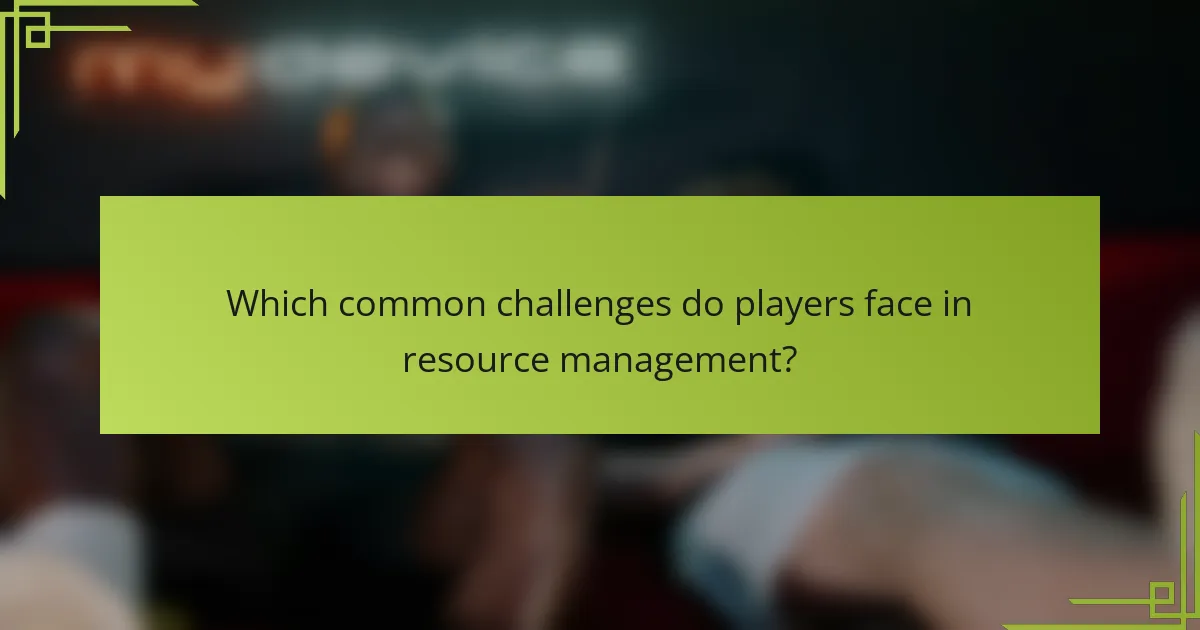
Which common challenges do players face in resource management?
Players in resource management face challenges such as scarcity of resources, inefficient allocation, balancing growth with sustainability, and managing player interactions. These issues can hinder effective community building and strategic development. Resource scarcity often forces players to make tough decisions, while inefficient allocation leads to wasted potential. Balancing growth with sustainability ensures long-term success, but requires careful planning. Finally, managing player interactions can create conflicts or alliances that impact resource distribution.
How can players overcome scarcity issues?
Players can overcome scarcity issues by implementing effective resource management strategies and fostering community collaboration. Prioritize gathering essential resources like food and materials through exploration and trade. Establishing alliances with other players enhances access to shared resources, mitigating individual scarcity. Utilize crafting systems to create items that optimize resource use, maximizing efficiency. Regularly assess resource levels to adjust strategies and avoid shortages. Engaging in community events can provide additional resources and strengthen player networks, ensuring a sustainable resource flow.
What are the consequences of poor resource management on community health?
Poor resource management negatively impacts community health by leading to inadequate access to essential services. This can result in increased disease prevalence, reduced mental well-being, and diminished overall quality of life. For example, lack of clean water and sanitation facilities can escalate health risks. Communities may experience higher healthcare costs and decreased productivity due to these health issues. As a result, effective resource management is crucial for promoting sustainable community health outcomes.
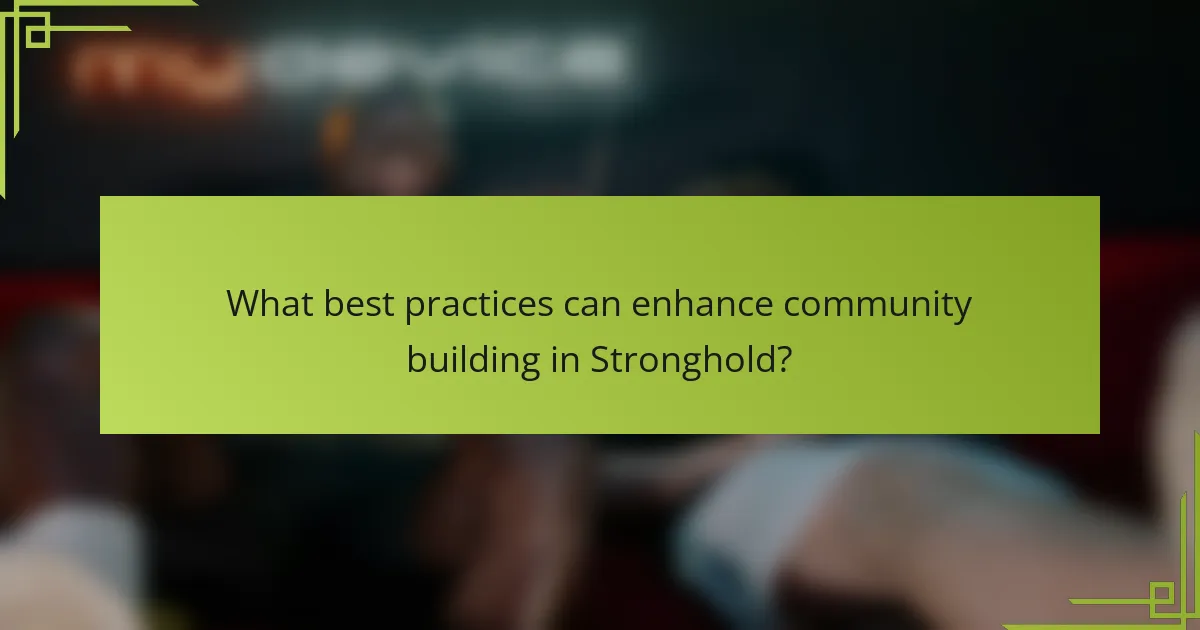
What best practices can enhance community building in Stronghold?
To enhance community building in Stronghold, focus on fostering collaboration, communication, and resource sharing. Establish clear roles within the community to encourage participation and accountability.
Encourage regular events and activities that promote interaction among players. This can include tournaments, resource trading, or cooperative missions. Create a supportive environment where players can share strategies and tips, enhancing collective knowledge.
Utilize in-game tools to facilitate communication, such as chat systems or forums. Providing platforms for discussion helps build relationships and a sense of belonging. Regularly solicit feedback from community members to adapt and improve activities, ensuring they meet players’ needs and interests.
What are the most common mistakes to avoid in community management?
The most common mistakes to avoid in community management include lack of clear communication, ignoring member feedback, failing to set community guidelines, and neglecting engagement strategies. These pitfalls can hinder community growth and member satisfaction.
Clear communication is essential; without it, misunderstandings arise. Ignoring feedback can diminish trust and participation. Setting community guidelines fosters a safe environment, while active engagement keeps members invested. Addressing these issues strengthens community dynamics.
How can players create a welcoming environment for newcomers?
Players can create a welcoming environment for newcomers by fostering inclusivity and providing support. Establishing clear communication channels encourages interaction and builds community. Organizing events or activities specifically for new players helps them integrate. Offering mentorship from experienced players can enhance their gaming experience, making them feel valued and included.
What expert tips can improve resource management strategies?
Effective resource management strategies can be enhanced through expert tips focusing on planning, prioritization, and community engagement.
1. Analyze resource allocation regularly to identify inefficiencies and areas for improvement.
2. Foster collaboration among community members to share resources and knowledge effectively.
3. Implement tracking systems to monitor resource usage and adjust strategies as needed.
4. Prioritize resource distribution based on community needs and project goals.